| View previous topic :: View next topic |
| Author |
Message |
stevemark

Joined: 29 Apr 2011
Posts: 3754
Location: Switzerland
|
 Posted: Mon Feb 13, 2023 11:23 pm Post subject: Posted: Mon Feb 13, 2023 11:23 pm Post subject: |
 |
|
stevemark wrote:
AF system, #2:
There's a dedicated rotary switch for selecting "manual focus", "single AF". "automatic AF" (switching automatically between "single" and "continuous") and "continuous AF".
In addition there's another AF/MF toggle switch, but more on that later!
Quite standard as well with many SLRs and DSLRs, but nicely made.
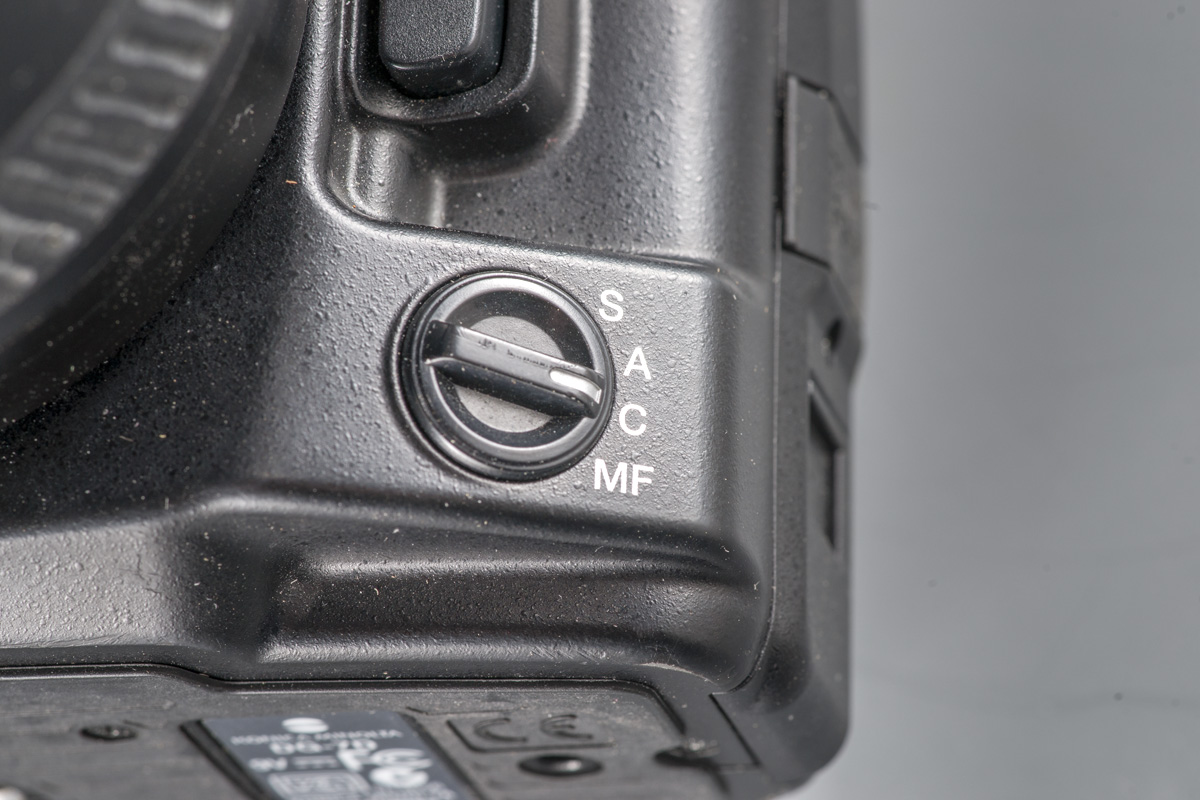
_________________
www.artaphot.ch
Last edited by stevemark on Tue Feb 14, 2023 12:16 am; edited 2 times in total |
|
| Back to top |
|
 |
stevemark

Joined: 29 Apr 2011
Posts: 3754
Location: Switzerland
|
 Posted: Tue Feb 14, 2023 12:04 am Post subject: Posted: Tue Feb 14, 2023 12:04 am Post subject: |
 |
|
stevemark wrote:
Finally the remaining control units!
As you can see, below the "M-S-A-P" selector theres a second rotary switch. That lower level give direct access to the "frame per second" menu. Since the D7D is fairly slow (3 fps), it has only the positions "single" and "continuous" (=3 fps).
However, with the same rotary switch you can directly engage the 10s and the 2s self-timer, the latter conveniently combined with mirrol lock up MLU).
And finally the switch has another two positions with direct access to the bracketing functions (again "single" or "continuous"). The number of frames for bracketing (three or five) and the respective EV difference betwee frames (1/3EV or 1/2EV) must first be programmed via the menu; once it is determined, the bracketing function can be accessed without diving into the menu. Quite remarkable indeed.
Below we see the "AEL" button ahich is very useful. Once it is pressed, the AE is locked. If a dedicated flash (or the built-in flash) is used, pressing the AEL button results in "slow sync" flash: half of the light is ambient ("available light"), ad half comes from the flashgun. This function came first with the analog Minolta AF cameras, and it was (is) extremely useful for reportage and wedding photography.
Around the AEL button there's another rotary switch, again with three positions for selecting the different light meteriung modes:
* spot
* multi metering
* average
Hidden under the eye-cup (barely visible) is the rotary knob for adjusting the diopters (+3 to -3 diopters). Another feat that was quite uncommon in prosumer cameras back then.
Finally - last but not least - we have the front- and the back wheel for adjusting aperture and shutter speed. Unlike the much more expensive professional Nikon and Canon DLSRs (D1 / D2 and 1D-series), the Minolta wheels had its wheels angled in an ergonomically perfect position (Nikon D1/D2 had its wheels just "laying flat" [=horizontally], and Canon EOS 1D / 1DMkII was perpendicular / 90°). Minolta (and Sony!) wheels are more expensive to produce, but much nicer to use ...!

OK - this was it ...! I have been using the D7D from Dec 2004 to Oct 2007, and it was a real improvement over my Nikon D1. Twice as much pixels, much better colors, and much easier to work with. Then, at the end of October 2007, I had the rare opportunity to work in Bhutan, and litterally on the evening before my departure I got one of the very first Sony A700 cameras available here in Switzerland. But that's another story 
S
EDIT: I forgot the "AF/MF" button! That one was added first to the anaolg Dynax 7 a few years ago. Minolta users had complained that Canon (and to some extent also Nikon) users had the ability for "direct manual focusing" when using lenses with an USM AF motor. In 2004 Minolta had only two lenses with USM (SSM) motors, the 2.8/70-200 APO G SSM and the 2.8/300 APO G SSM. Nobody was using them, and for all the "screwdriver" lens users Minolta added the "AF/MF" switch: Press the button => lens is MF; let loose => AF again ...
Well, it wasn't as useful as they had hoped, and it required an additional (expensive) clutch mechanism in the AF drivetrain ... !
_________________
www.artaphot.ch |
|
| Back to top |
|
 |
stevemark

Joined: 29 Apr 2011
Posts: 3754
Location: Switzerland
|
 Posted: Tue Feb 14, 2023 11:13 pm Post subject: Posted: Tue Feb 14, 2023 11:13 pm Post subject: |
 |
|
stevemark wrote:
Here's another one, about 25 years old now - the Minolta Dynax (Maxxum) 9. It was (and is) one of my favourite analog SLRs, along with such classics as the Canon New F-1, the Nikon F3 and F5, and the Pentax LX. Here it's shown with my recently acquired Minolta AF 2.8/28-70mm G zoom which was Minoltas best (and most expensive) standard zoom.
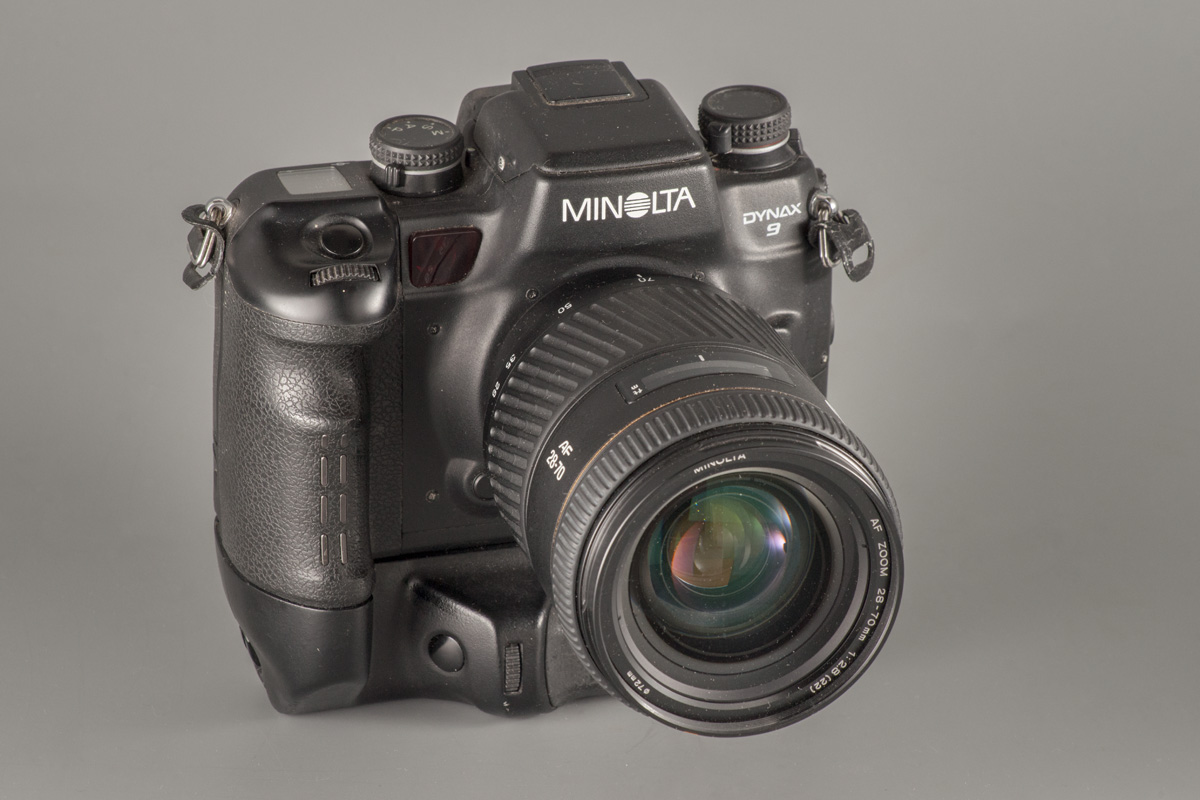
Apart from the fact that the Dynax 9 did have a built-in flash, it was unique since its body was made from stainless steel. The camera therefore was extremely rugged; I remember it once fell (during a rock concert; dense crowd and quite a crush) on the concrete floor below - and continued working. Maybe a year or so later I tripped over someting while rushing for a train; the D9 literally was kicked off my hands, flew 3-4 meters through the air and fell ... well: on concrete, again. This time - while the camera was still working - the upper part of the body was slightly twisted, and there was small gap between upper part and mid-section. Maybe half a millimeter, but enough that the body wouldn't be protected against moisture any more. It had to be repaired at Minolta Switzerland.

If you look at both the camera grip and the vertical grip, you can see how much attention to detail the camera was given. Those grips are much better than anything that CaNikon have produced in the SLR/DSLR field. The camera was extremely responsive. Those metal strips on the grip are activating the Dynax 9 as soon as you pick it up, and when you approach the viewfinder, another sensor is activating the autofocus. While I never really liked the earlier Dynax (Maxxum) 9xi, the Dynax 9 was an immediate joy to work with. It is no secret that the later "digital D9" - which was later released as the Sony A900 - was a direct descendant of the Minolta Dynax 9.

S
_________________
www.artaphot.ch |
|
| Back to top |
|
 |
Doc Sharptail


Joined: 23 Nov 2020
Posts: 987
Location: Winnipeg Canada
|
 Posted: Wed Feb 15, 2023 6:40 am Post subject: Posted: Wed Feb 15, 2023 6:40 am Post subject: |
 |
|
Doc Sharptail wrote:
From a user standpoint- physical ergonomics only, the grips on the MD-11 & MD-12 (FM & FE) were about the best "feel" in my hands.
While not as technologically advanced as the Minolta offerings above, they made perfect physical sense to me.
The MD-4 on the F3 was a big, chunky, blocky, and heavy poorly designed contraption that I had little interest in, but there are legions of F3 users that loved it, and swore by it as well.
I've gotten used to the grip on the D-810.
Personally, I find the design a little cramped, and still need care to not un-intentionally activate the function- a/f-a/e lock buttons. A 2 or 3 mm wider spacing between the grip and the lens mount would work wonders. I'd need to go to the D-5/6 to get it though.
-D.S.
_________________
D-810, F2, FTN.
35mm f2 O.C. nikkor
50 f2 H nikkor, 50 f 1.4 AI-s, 135 f3.5 Q,
50 f2 K nikkor 2x, 28-85mm f3.5-4.5 A/I-s, 35-105 3.5-4.5 A/I-s, 200mm f4 Micro A/I, partial list.
"Ain't no half-way" -S.R.V.
"Oh Yeah... Alright" -Paul Simon |
|
| Back to top |
|
 |
ZuikosHexanonsandVivitars


Joined: 03 Nov 2021
Posts: 223
Location: Austria
|
 Posted: Wed Feb 15, 2023 1:20 pm Post subject: Posted: Wed Feb 15, 2023 1:20 pm Post subject: |
 |
|
ZuikosHexanonsandVivitars wrote:
| stevemark wrote: |
| ZuikosHexanonsandVivitars wrote: |
My OM-2N and the two silver noses I own.
|
A very nice camera for sure! Sadly the Zuiko lenses are quite scarce here in Switzerland (apart from ubiquituous 1.8/50, 3.5/28 and 3.5/135 Zuikos), and in addition tho the 1.8/50 and the 3.5/28 I only have a 3.5/21, the 1.4/50, the 2.8/135 and the 4.5/300 (plus a few zooms).
| ZuikosHexanonsandVivitars wrote: |
This OM-2SP ate batteries like candies, luckily of the LR-44 type. So supply is still good, I might try a color negative film with it once the Ilford in the OM-3 is spent. I bought this camera in the 90s, when everybody was keen on autofocus, for very little money.
|
OM-3 and 2.8/180 ... what a beautiful combination! I've never seen a 2.8/180, and i would love to see how it performs since its construction is a bit different from most other fast 180mm / 200mm lenses.
S |
Stefan, I didn´t notice your reply (until today), sorry for that!
Since I started again looking for Zuikos on ebay & co. some two years ago, they became more and more scarce everywhere. So I´m quite happy with what I have from analog times. Still, my Olympus lenses are nothing a collector would get excited about. But they are a very practical set of lenses mostly f2.8 and covering almost the whole range from 24 to 300mm. The usual surplus of fifties, whereas the 1.4 with its 1.1mio serial number and the 1.2 stick out a bit. Sadly, I never had a good opportunity to get a 85mm Zuiko. They always were expensive.
My three teles of 100/2.8, 135/2.8 and 180/2.8 are all MC, and I am damn happy about that. Only the 300mm f4.5 is a black single coated version and therefore fringing heavily. Apart from this one, all Zuikos are solid to outstanding performers and produce a "modern" look without or very little hints of vintage nostalgy.
I haven´t used the 180mm often recently, but it´s a good idea to change that if the weather is not abysmal coming weekend. From the few occasions in recent months I find it has a pleasant bokeh, is already sharp wide open, being best (as usual) from f4 to f8, has good contrasts and color rendition. If a comparison in such way is legit at all, I´d say it keeps performance-wise slightly behind the shorter 100/2.8 and 135/2.8, which are just excellent. A big treat comes from the handy form factor of the 180/2.8. Olympus has filed a patent for this lens in the US, calling it a "variant Ernostar type long focus lens system having a very short overall length".
https://image-ppubs.uspto.gov/dirsearch-public/print/downloadPdf/4114992
Afore mentioned 135mm and 100mm lenses have a similar 5-lens configuration. It might be that Olympus has reached a useful limit of this config around 180mm. Or they have outmaxed it in their desire to create a light and short lens. Both could explain the slightly less good performance of the 180/2.8 in comparison to the other two (which is still my very personal perception and humble opinion). Being not educated in this area, I can only speculate, but looking at the rare and expensive Zuiko 180mm f2.0, which uses 10 instead of 5 lenses, is probably the best way to see what Olympus could do, if optical excellence is prime and money (and bag capacity  ) a secondary issue. ) a secondary issue.
_________________
Cheers, Gerhard |
|
| Back to top |
|
 |
stevemark

Joined: 29 Apr 2011
Posts: 3754
Location: Switzerland
|
 Posted: Tue Feb 21, 2023 5:43 pm Post subject: Posted: Tue Feb 21, 2023 5:43 pm Post subject: |
 |
|
stevemark wrote:
| ZuikosHexanonsandVivitars wrote: |
Sadly, I never had a good opportunity to get a 85mm Zuiko. They always were expensive. |
Did you know there was a very sophisticated Olmpus Zuiko 1.4/85mm, too? Prototype only, though ... 
| ZuikosHexanonsandVivitars wrote: |
| My three teles of 100/2.8, 135/2.8 and 180/2.8 are all MC, and I am damn happy about that. |
I only know the 2.8/135mm which I got a year ago for about CHF 40.-- from a photo dealer in Zurich. To be honest - I haven't really been using it, just a few test shots. Maybe I should try it again. Both the 2.8/100mm (which occasionally appears here in Switzerland) and the 2.8/180 look pretty interesting to me, but since they usually are pretty expensive I didn't buy them. And collecting the more interesting f2 Oly lenses immediately gets even more expensive. occasionally they appear here, too, but the sellers often want >1000.-- for these lenses (2/21, 2/24, 2/50 Macro, 2/90 Macro, 2/100).
| ZuikosHexanonsandVivitars wrote: |
| Only the 300mm f4.5 is a black single coated version and therefore fringing heavily. Apart from this one, all Zuikos are solid to outstanding performers and produce a "modern" look without or very little hints of vintage nostalgy. |
Dunno how you distinguish between "MC" and "non-MC" Zuikos - but mine has some single coated lenses (brownish coating) and some multi coated lenses (greenish coating). My Olympus Zuiko 4.5/300 fringes quite a bit too, but that's more a problem of the focal length than of coating. Most vintage 300mm do this, apart from the "APO" / ULD / ED / AD glass. Even the Nikkor AiS IF-ED 4.5/300mm has quite a lot of fringing!
| ZuikosHexanonsandVivitars wrote: |
I haven´t used the 180mm often recently, but it´s a good idea to change that if the weather is not abysmal coming weekend. From the few occasions in recent months I find it has a pleasant bokeh, is already sharp wide open, being best (as usual) from f4 to f8, has good contrasts and color rendition. If a comparison in such way is legit at all, I´d say it keeps performance-wise slightly behind the shorter 100/2.8 and 135/2.8, which are just excellent. A big treat comes from the handy form factor of the 180/2.8. Olympus has filed a patent for this lens in the US, calling it a "variant Ernostar type long focus lens system having a very short overall length".
https://image-ppubs.uspto.gov/dirsearch-public/print/downloadPdf/4114992 |
Thanks for that information, especially for the linked US patent info. The optical construction of the Oly 2.8/180 is even more unusual than I had anticipated. Not only is the lens section stronlgy reminding of certain 135 mm lenses, but also the glasses used have a surprisingly high refractive index (around 1.64 - 1.7 for the first three large positive lenses), but also their Abbé number is surprisingly low (= stronger CAs). An Abbé number of 50 to 55 is really unusual for a fast f2.8 tele with about 200mm focal length!! Canon was using an LD glass with an Abbé number of 70 even for their slow nFD 4/200mm ...
| ZuikosHexanonsandVivitars wrote: |
| Afore mentioned 135mm and 100mm lenses have a similar 5-lens configuration. It might be that Olympus has reached a useful limit of this config around 180mm. Or they have outmaxed it in their desire to create a light and short lens. Both could explain the slightly less good performance of the 180/2.8 in comparison to the other two (which is still my very personal perception and humble opinion). |
That's probably quite accurate. Going for "small lenses", Olympus went fro the Ernostar design even with its 200mm class lens, while most other contemporary 2.8/200mm lenses were tele constructions with a triplet in front and a negative doublet at the rear (to shorten the overall length of the system, and to correct for field curvature). Those triplets often had their two positive lenses made
from ED glass with an Abbé number v=70. Notable exceptions were the Konica Hexanon AR 4/200mm (v=64, which means more CAs), and the Nikkor ED 2.8/180 with ULD glass (v about 80, which means better color correction).
| ZuikosHexanonsandVivitars wrote: |
Being not educated in this area, I can only speculate, but looking at the rare and expensive Zuiko 180mm f2.0, which uses 10 instead of 5 lenses, is probably the best way to see what Olympus could do, if optical excellence is prime and money (and bag capacity  ) a secondary issue. ) a secondary issue. |
That one is a later construction of course. The Olympus 2/180mm, 2/250mm and 2.8/350mm lenses are at least ten years younger than the Oly 2.8/180mm. Now ED/ULD (originally by Schott) and AD (Minolta) glass and even Fluorite (Canon) was available in reasonable amounts, thus allowing the calculation and production of much more sophisticated lens designs.
S
_________________
www.artaphot.ch |
|
| Back to top |
|
 |
stevemark

Joined: 29 Apr 2011
Posts: 3754
Location: Switzerland
|
 Posted: Tue Feb 21, 2023 7:46 pm Post subject: Nikon F3 with different lenses Posted: Tue Feb 21, 2023 7:46 pm Post subject: Nikon F3 with different lenses |
 |
|
stevemark wrote:
Usually cameras shown here have just their normal lens attached. An 1.4/50, an 1.7/55 or whatever. Sometimes we see a fast lens, sometimes an "ordinary" 4/35mm wideangle. Or a 4/135mm tele lens.
That's not only true here, but also in the entire web. One rarely finds nice images of nice cameras with a nice fast lens attached.
The first 50 hits when searching for images using "Nikon F3 Nikkor 1.8 105mm" for instance were displaying two images of the 1.8/105mm with an FM3A, one image of the 1.8/105mm with an FA, but none with the F3. All other images show either only the 1.8/105mm lens, or (mostly) just other lenses and/or cameras. Pretty poor.
Let's change that 
Here are a few images of a Nikon F3 with different fast lenses. Nothing special or rare at all, but nevertheless ... just for fun  ! !
First the F3 with a nice Nikkor Ai 1.2/55mm normal lens:

F3 with an Ai converted Nikkor K 1.8/85mm:
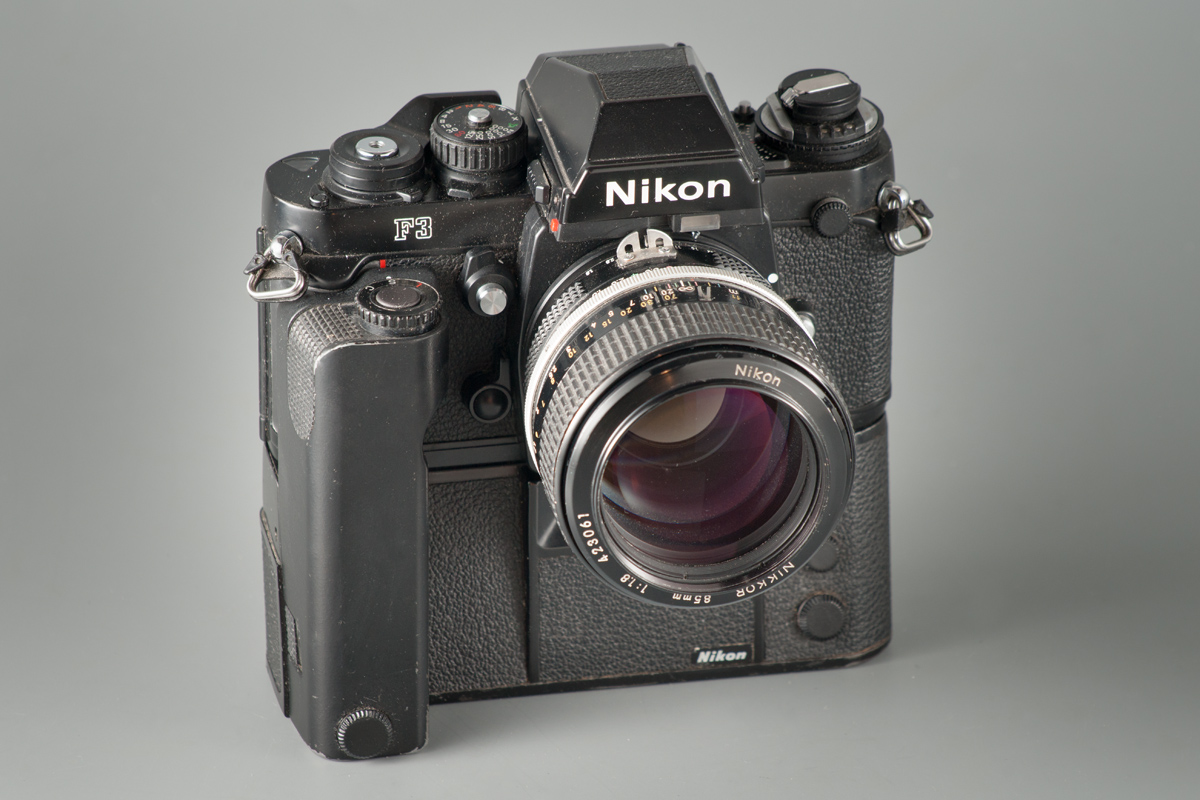
Here with the large and fast Nikkor AiS 1.8/105mm:
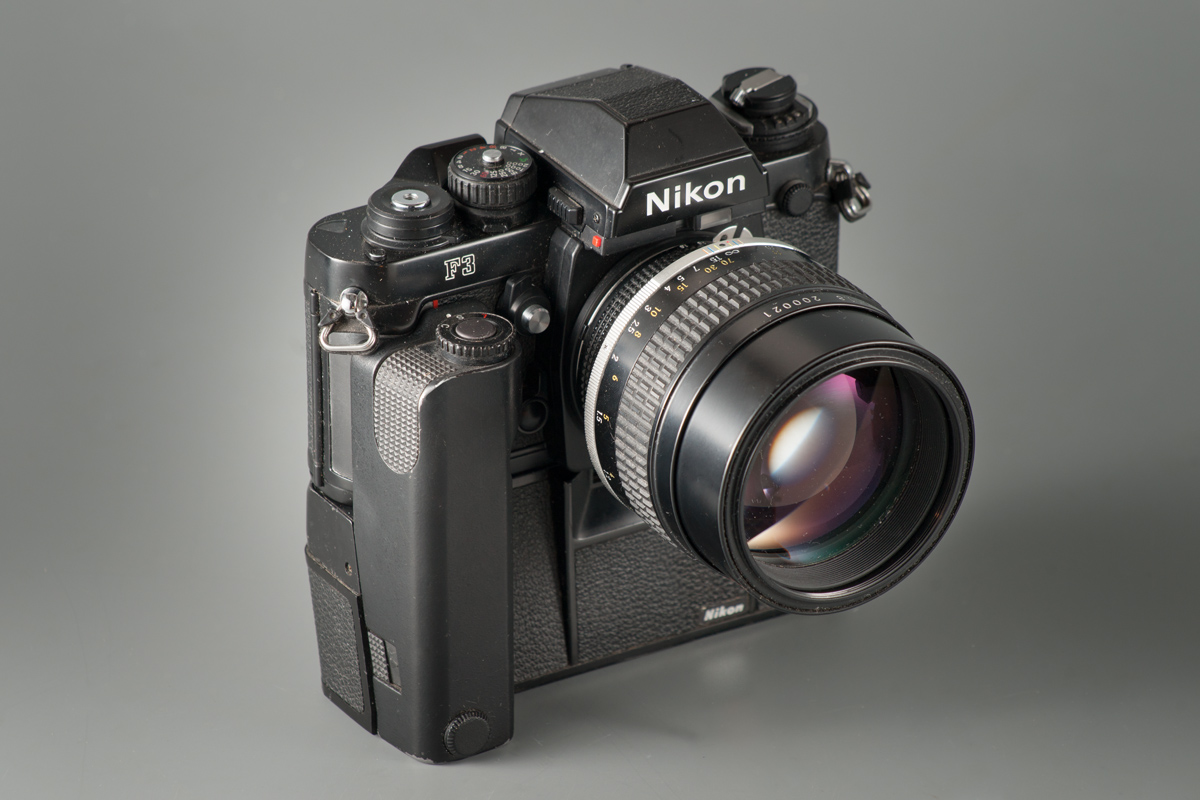
And finally with a nice looking Nikkor AiS 2.8/180mm ED:
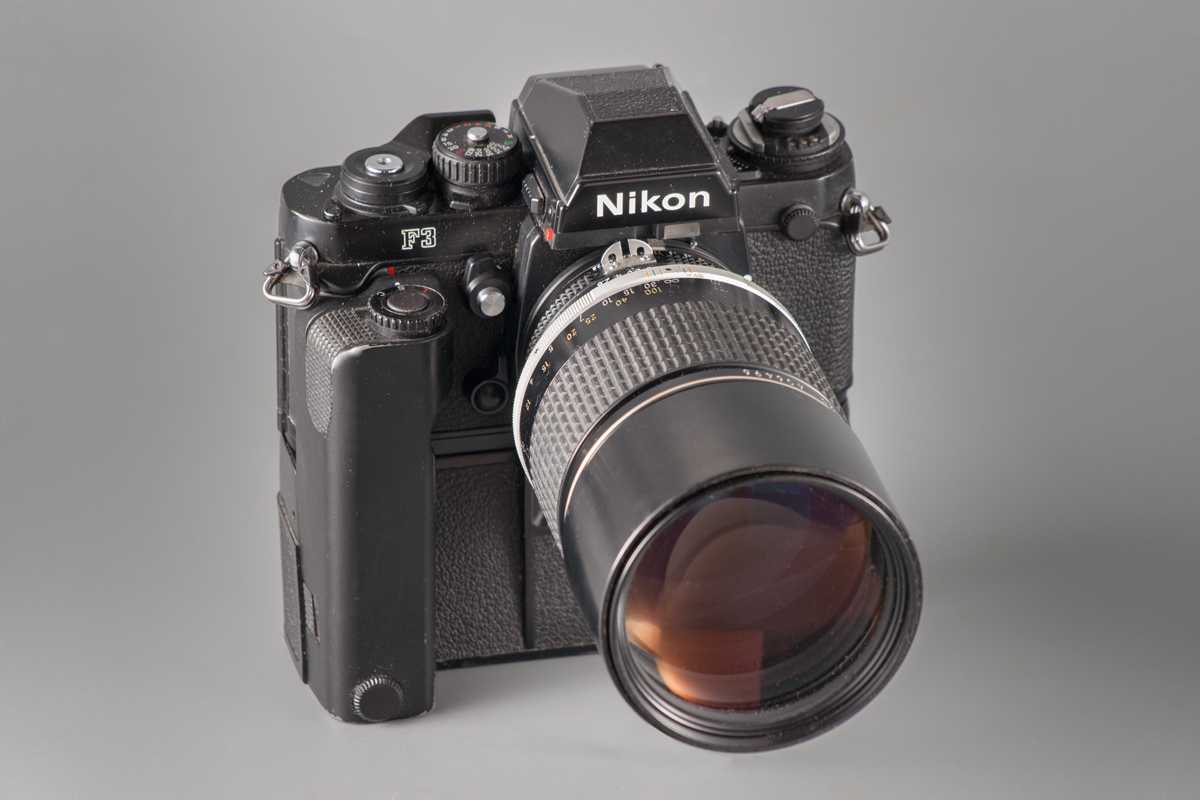
_________________
www.artaphot.ch |
|
| Back to top |
|
 |
kansalliskala


Joined: 19 Jul 2007
Posts: 5028
Location: Southern Finland countryside
Expire: 2016-12-30
|
 Posted: Wed Feb 22, 2023 6:22 am Post subject: Re: Nikon F3 with different lenses Posted: Wed Feb 22, 2023 6:22 am Post subject: Re: Nikon F3 with different lenses |
 |
|
kansalliskala wrote:
| stevemark wrote: |
And finally with a nice looking Nikkor AiS 2.8/180mm ED:
 |

is it glued on the table?
_________________
MF: Kodak DCS SLR/c; Samsung NX10; OM-10; Canon T50
Zuiko 28/3.5, Distagon 35/2.8; Yashica ML 50/2;
Zuiko 50/1.4; S-M-C 120/2.8; Zuiko 135/3.5; 200/5;
Tamron AD1 135/2.8, Soligor 180/3.5; Tamron AD1 300/5.6
Tamron zooms: 01A, Z-210
Yashicaflex C; Київ 4 + Юпитер 8, 11; Polaroid 100; Olympus XA; Yashica T3
Museum stuff: Certo-Phot; Tele-Edixon 135; Polaris 90-190; Asahi Bellows; Ixus IIs
Projects: Agfa Isolette III (no shutter), Canon AE-1D (no sensor),
Nikon D80 (dead), The "Peace Camera"
AF: Canon, Tokina, Sigma Video: JVC GZ-MG275E |
|
| Back to top |
|
 |
Doc Sharptail


Joined: 23 Nov 2020
Posts: 987
Location: Winnipeg Canada
|
 Posted: Wed Feb 22, 2023 6:38 pm Post subject: Re: Nikon F3 with different lenses Posted: Wed Feb 22, 2023 6:38 pm Post subject: Re: Nikon F3 with different lenses |
 |
|
Doc Sharptail wrote:
| kansalliskala wrote: |

is it glued on the table? |
No- the F-3 was literally a heavy-weight with the MD-4 and it's 8 ( ! ) A/A batteries.
IIRC, it took the old vivitar series 1 70-210 f3.5 to tilt it with a full battery pack.
It stayed level with everything else.
While not a personal favorite, the system despite a few design flaws was a good one, and a bit of a prestige symbol as well.

This is more my speed here. YMMV! 
Driveless chrome F2 with Soligor 135mm aboard.
Note lens cap support below the lens.
-D.S.
_________________
D-810, F2, FTN.
35mm f2 O.C. nikkor
50 f2 H nikkor, 50 f 1.4 AI-s, 135 f3.5 Q,
50 f2 K nikkor 2x, 28-85mm f3.5-4.5 A/I-s, 35-105 3.5-4.5 A/I-s, 200mm f4 Micro A/I, partial list.
"Ain't no half-way" -S.R.V.
"Oh Yeah... Alright" -Paul Simon
Last edited by Doc Sharptail on Fri Feb 24, 2023 8:13 am; edited 1 time in total |
|
| Back to top |
|
 |
stevemark

Joined: 29 Apr 2011
Posts: 3754
Location: Switzerland
|
 Posted: Thu Feb 23, 2023 12:09 am Post subject: Re: Nikon F3 with different lenses Posted: Thu Feb 23, 2023 12:09 am Post subject: Re: Nikon F3 with different lenses |
 |
|
stevemark wrote:
| kansalliskala wrote: |

is it glued on the table? |
 ... No. Just an (invisible) match supporting the lens. ... No. Just an (invisible) match supporting the lens.
The F3 motor drive - as Doc has mentioned - has a flat bottom. This, combined with the grip's bottom (which also is flat), results in the "F3 & motor" standing really stable.
| Doc Sharptail wrote: |
While not a personal favorite, the system despite a few design flaws was a good one, and a bit of a prestige symbol as well.
This is more my speed here. YMMV! 
Driveless chrome F2 with Soligor 135mm aboard.
Note lens cap support below the lens.
-D.S. |
The F3 is a really nice camera. Without motor drive it is pretty small. Also the FE2 is fantastic. It has just all what you really need in an MF SLR, but nothing more. "F2 & lens" images will follow later on, but for time being here my Canon EOS 1D MkII with the 17mm shift lens attached 

S
_________________
www.artaphot.ch |
|
| Back to top |
|
 |
ZuikosHexanonsandVivitars


Joined: 03 Nov 2021
Posts: 223
Location: Austria
|
 Posted: Thu Feb 23, 2023 11:06 pm Post subject: Posted: Thu Feb 23, 2023 11:06 pm Post subject: |
 |
|
ZuikosHexanonsandVivitars wrote:
| stevemark wrote: |
Did you know there was a very sophisticated Olympus Zuiko 1.4/85mm, too? Prototype only, though ...  |
Yes, I knew!  Since I regularly visit this website here, I happened to come across the article of the 1.4/85 prototype. Lots of other interesting stuff in there, i.e. the patent no. I mentioned in my previous post I found there. Since I regularly visit this website here, I happened to come across the article of the 1.4/85 prototype. Lots of other interesting stuff in there, i.e. the patent no. I mentioned in my previous post I found there.
https://olypedia.de/index.php?title=OM-System
| stevemark wrote: |
I only know the 2.8/135mm which I got a year ago for about CHF 40.-- from a photo dealer in Zurich. To be honest - I haven't really been using it, just a few test shots. Maybe I should try it again. Both the 2.8/100mm (which occasionally appears here in Switzerland) and the 2.8/180 look pretty interesting to me, but since they usually are pretty expensive I didn't buy them. And collecting the more interesting f2 Oly lenses immediately gets even more expensive. occasionally they appear here, too, but the sellers often want >1000.-- for these lenses (2/21, 2/24, 2/50 Macro, 2/90 Macro, 2/100). |
http://forum.mflenses.com/olympus-zuiko-135mm-f2-8-sunrise-t84067.html
Not very helpful if one wants to judge the capability of a lens, but beautiful nevertheless. I should use it more often, too. Congratulations on the price of yours... 
I didn´t forget about the 180mm test images I mentioned in my previous post. I´ll be in the mountains next week and will take it with me, hoping for the muse to kiss me. I took a few images with it so far, but nothing good enough for a new topic in the galleries.
| stevemark wrote: |
| My Olympus Zuiko 4.5/300 fringes quite a bit too, but that's more a problem of the focal length than of coating. Most vintage 300mm do this, apart from the "APO" / ULD / ED / AD glass. Even the Nikkor AiS IF-ED 4.5/300mm has quite a lot of fringing! |
Thanks for mentioning that. I had the slight hope to run across an MC version sooner or later and grab it. I might reconsider 
_________________
Cheers, Gerhard |
|
| Back to top |
|
 |
stevemark

Joined: 29 Apr 2011
Posts: 3754
Location: Switzerland
|
 Posted: Fri Feb 24, 2023 2:20 am Post subject: Posted: Fri Feb 24, 2023 2:20 am Post subject: |
 |
|
stevemark wrote:
| ZuikosHexanonsandVivitars wrote: |
| stevemark wrote: |
| My Olympus Zuiko 4.5/300 fringes quite a bit too, but that's more a problem of the focal length than of coating. Most vintage 300mm do this, apart from the "APO" / ULD / ED / AD glass. Even the Nikkor AiS IF-ED 4.5/300mm has quite a lot of fringing! |
Thanks for mentioning that. I had the slight hope to run across an MC version sooner or later and grab it. I might reconsider  |
If you want a "cheap" FF lens in the 300mm range which is APO, get the Mamiya Sekor C 5.6/300mm. No need to get the later Mamiya Sekor C 5.6/300mm ULD (I have both, and they are absolutely identical). Both Mamiya Sekor C 5.6/300mm lenses mentioned are (in the visible) as good as the legendary Nikkor Ai 4.5/300mm ED "non-IF" which is corrected from 400nm to 1000nm. I can't check its IR performance though ...
_________________
www.artaphot.ch |
|
| Back to top |
|
 |
stevemark

Joined: 29 Apr 2011
Posts: 3754
Location: Switzerland
|
 Posted: Fri Feb 24, 2023 5:48 pm Post subject: Posted: Fri Feb 24, 2023 5:48 pm Post subject: |
 |
|
stevemark wrote:
I usually don't collect the German SLRs from the 1950s and 1960s. Nevertheles a few of them have accumulated here, usually saved from the wastebin of local photo stores. A few Contaflexes, a few edixas, some Contax Jena SLRs, and similar stuff nobody wants to keep any more. Whil I do have a few nice lenses fo the DKL mount, I never had anything else than the common 2.8/50mm Tessars when it came to my Contaflexes. Some weeks ago I saw a few Contaflex lenses for sale, and yesterday I picked them up. The guy selling them has a lot of interesting glass, and we may run some tests and comparisons in the future.
Now here's the "newest" of my Contaflexes, together with the three lenses
* Tessar 2.8/50mm
* Pro-Tessar 3.2/35mm
* Pro-Tessar 4/85mm
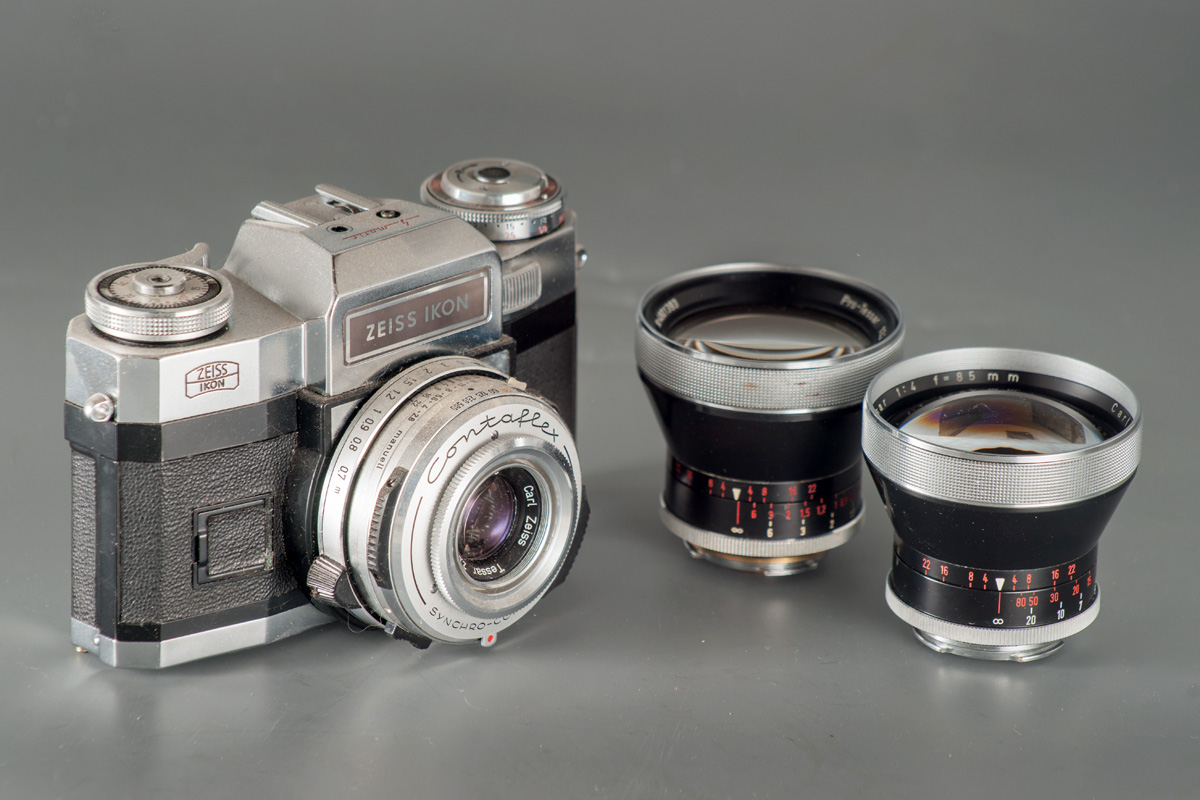
Those two Pro-Tessar "plug-in"-lenses are replacing the front lens of the classical 2.8/50mm Tessar while the three last lenses remain fixed within the Contaflex body. They are large, very well built and heavy: 305 g for the Pro-Tessar 3.2/35mm, and 275 g for the Pro-Tessar 4/85 mm. Especially the 85mm is prone to lens separation (rainbow colors reflecting from a cemented surface), but it seems in practise this isn't a big problem.
Mounted on the camera, the 35mm Pro-Tessar looks actually pretty nice (and you can see the separation issue on the 4/85mm as well):

When I got the two Pro-Tessars there was another very similar lens included, the Schneider Longar-Xenon C 4/80mm. That one was made for the Kodak Retina SLR (well, for some at least ...). There were those Retinas equipped with Schneider lenses, and others with Rodenstock lenses. Schneider Longars / Curtars would fit the Schneider Retinas, and Rodenstock converters would fit the Rodenstock Retinas. They were not compatible.
Here's a Retina Reflex with a fast Schneider Xenon 2/50mm normal lens and a much slower Longar-Xenon C 4/80mm:
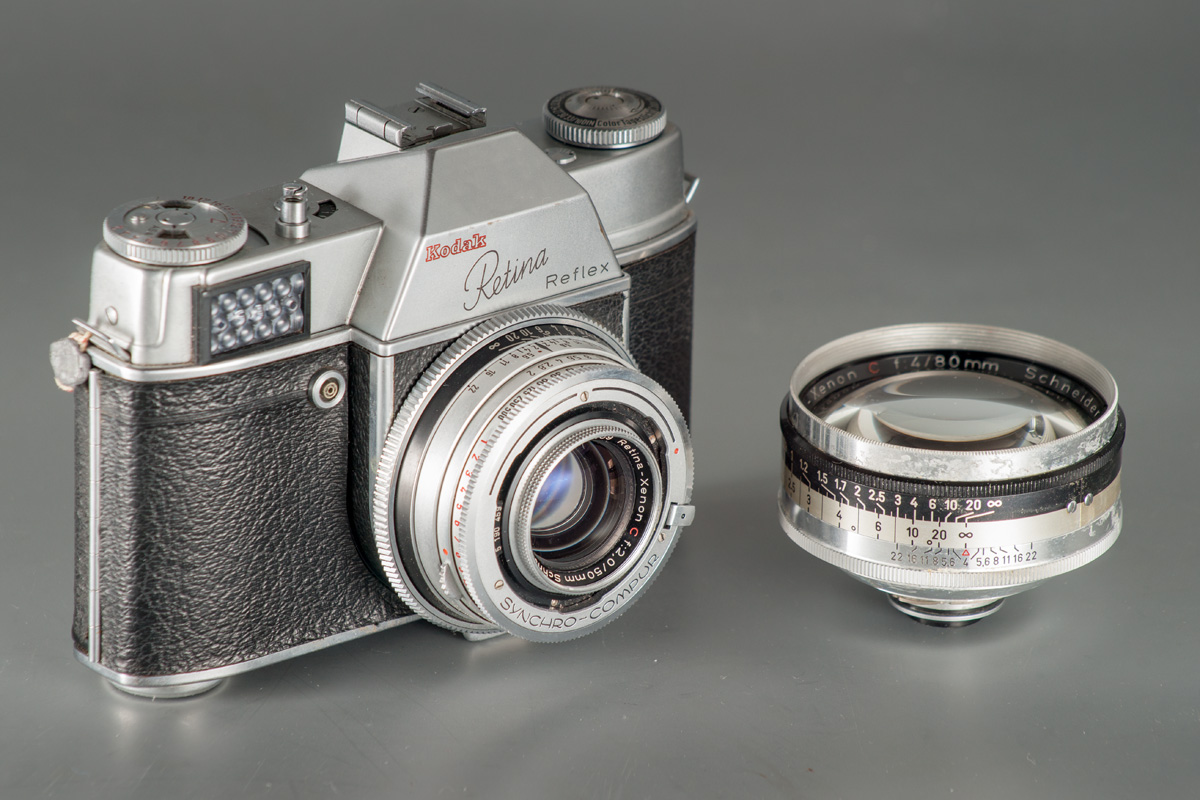
Those Schneider lenses have no problems with separation, but they have - to some degree - "Schneideritis" 
S
_________________
www.artaphot.ch |
|
| Back to top |
|
 |
Doc Sharptail


Joined: 23 Nov 2020
Posts: 987
Location: Winnipeg Canada
|
 Posted: Sat Feb 25, 2023 3:06 am Post subject: Posted: Sat Feb 25, 2023 3:06 am Post subject: |
 |
|
Doc Sharptail wrote:
I often wonder about Kodak.
Eastman seemed to be fairly rigidly into the cheap and fast to fabricate.
The Retina line seems a bit of a departure from that line of thought.
If they had been a little more interested in producing their own glass, things may have gotten very interesting indeed.
-D.S.
_________________
D-810, F2, FTN.
35mm f2 O.C. nikkor
50 f2 H nikkor, 50 f 1.4 AI-s, 135 f3.5 Q,
50 f2 K nikkor 2x, 28-85mm f3.5-4.5 A/I-s, 35-105 3.5-4.5 A/I-s, 200mm f4 Micro A/I, partial list.
"Ain't no half-way" -S.R.V.
"Oh Yeah... Alright" -Paul Simon |
|
| Back to top |
|
 |
kansalliskala


Joined: 19 Jul 2007
Posts: 5028
Location: Southern Finland countryside
Expire: 2016-12-30
|
 Posted: Sat Feb 25, 2023 6:37 am Post subject: Posted: Sat Feb 25, 2023 6:37 am Post subject: |
 |
|
kansalliskala wrote:
| Doc Sharptail wrote: |
I often wonder about Kodak.
Eastman seemed to be fairly rigidly into the cheap and fast to fabricate.
The Retina line seems a bit of a departure from that line of thought.
If they had been a little more interested in producing their own glass, things may have gotten very interesting indeed.
-D.S. |
I think Kodak has been kind on two lines: one is highly innovative and the other really big mass production.
_________________
MF: Kodak DCS SLR/c; Samsung NX10; OM-10; Canon T50
Zuiko 28/3.5, Distagon 35/2.8; Yashica ML 50/2;
Zuiko 50/1.4; S-M-C 120/2.8; Zuiko 135/3.5; 200/5;
Tamron AD1 135/2.8, Soligor 180/3.5; Tamron AD1 300/5.6
Tamron zooms: 01A, Z-210
Yashicaflex C; Київ 4 + Юпитер 8, 11; Polaroid 100; Olympus XA; Yashica T3
Museum stuff: Certo-Phot; Tele-Edixon 135; Polaris 90-190; Asahi Bellows; Ixus IIs
Projects: Agfa Isolette III (no shutter), Canon AE-1D (no sensor),
Nikon D80 (dead), The "Peace Camera"
AF: Canon, Tokina, Sigma Video: JVC GZ-MG275E |
|
| Back to top |
|
 |
stevemark

Joined: 29 Apr 2011
Posts: 3754
Location: Switzerland
|
 Posted: Tue Feb 28, 2023 5:08 pm Post subject: Posted: Tue Feb 28, 2023 5:08 pm Post subject: |
 |
|
stevemark wrote:
| Doc Sharptail wrote: |
I often wonder about Kodak.
Eastman seemed to be fairly rigidly into the cheap and fast to fabricate. |
... for the American market!
| Doc Sharptail wrote: |
The Retina line seems a bit of a departure from that line of thought. |
For the German (and partly also the European) market.
The Retina series, started in 1934, was produced by Nagel in Stuttgart (south-western Germany). The first Retinas (1934) were folders, not SLRs, and hat either Schneider or Rodenstock lenses (not Zeiss though - they of course had their own cameras). Later on, in the 1950s, not only the original f2.8 lenses were supplied, but also f2 normal lenses and - as shown above - some wideangle and tele converters. Some of them were useable on both the folders and the later SLRs, but I don't know the details since I only have Retina SLRs (and no folders [yet]).
| Doc Sharptail wrote: |
If they had been a little more interested in producing their own glass, things may have gotten very interesting indeed.
-D.S. |
Kodak did produce excellent glass, but probably the distance (both geografically as well as politically/economically) between the US and Germany was a problem. Were those 1950s rangefinders and SLRs available in the US or in Canada? And would "Kodak" (back then a synonyme for slide film and cheap box cameras, at least here in Switzerland) lenses selling well in a country were Zeiss, Leitz, Schneider and Rodenstock were well known for their quality?
S
_________________
www.artaphot.ch |
|
| Back to top |
|
 |
Doc Sharptail


Joined: 23 Nov 2020
Posts: 987
Location: Winnipeg Canada
|
 Posted: Wed Mar 01, 2023 1:40 am Post subject: Posted: Wed Mar 01, 2023 1:40 am Post subject: |
 |
|
Doc Sharptail wrote:
| stevemark wrote: |
| Doc Sharptail wrote: |
I often wonder about Kodak.
Eastman seemed to be fairly rigidly into the cheap and fast to fabricate. |
... for the American market!
| Doc Sharptail wrote: |
The Retina line seems a bit of a departure from that line of thought. |
For the German (and partly also the European) market.
The Retina series, started in 1934, was produced by Nagel in Stuttgart (south-western Germany). The first Retinas (1934) were folders, not SLRs, and hat either Schneider or Rodenstock lenses (not Zeiss though - they of course had their own cameras). Later on, in the 1950s, not only the original f2.8 lenses were supplied, but also f2 normal lenses and - as shown above - some wideangle and tele converters. Some of them were useable on both the folders and the later SLRs, but I don't know the details since I only have Retina SLRs (and no folders [yet]).
| Doc Sharptail wrote: |
If they had been a little more interested in producing their own glass, things may have gotten very interesting indeed.
-D.S. |
Kodak did produce excellent glass, but probably the distance (both geografically as well as politically/economically) between the US and Germany was a problem. Were those 1950s rangefinders and SLRs available in the US or in Canada? And would "Kodak" (back then a synonyme for slide film and cheap box cameras, at least here in Switzerland) lenses selling well in a country were Zeiss, Leitz, Schneider and Rodenstock were well known for their quality?
S |
I don't know 
I have read that their earliest folders had glass ground by Wollensak, and later, others.
There is an awful lot to the company history.
They did make glass on what I think is a small scale at first.
There was a bakelite bodied Hawkeye roll film camera that my parents had, with kodak markings on the lens barrel, which is the first that I was aware of. The shutter in it was a simple single speed metal tab. The slide film projector lenses came quite a bit after that.
I should look at my kodak folder again for markings.
-D.S.
_________________
D-810, F2, FTN.
35mm f2 O.C. nikkor
50 f2 H nikkor, 50 f 1.4 AI-s, 135 f3.5 Q,
50 f2 K nikkor 2x, 28-85mm f3.5-4.5 A/I-s, 35-105 3.5-4.5 A/I-s, 200mm f4 Micro A/I, partial list.
"Ain't no half-way" -S.R.V.
"Oh Yeah... Alright" -Paul Simon |
|
| Back to top |
|
 |
Doc Sharptail


Joined: 23 Nov 2020
Posts: 987
Location: Winnipeg Canada
|
 Posted: Wed Mar 01, 2023 5:51 pm Post subject: Re: Nikon F3 with different lenses Posted: Wed Mar 01, 2023 5:51 pm Post subject: Re: Nikon F3 with different lenses |
 |
|
Doc Sharptail wrote:
| stevemark wrote: |
| "F2 & lens" images will follow later on, S |

Here's one with an almost "period correct" lens.
I still have the pre A/I "K" 50mm f2 that the seller assured me shipped with the camera.

One of the "accessories" that came in an earlier package deal.
Nikon marked dampened soft-touch release button.
I don't really use it very often- it turns an early ergonomic wonder into something a bit clumsier.
-D.S.
_________________
D-810, F2, FTN.
35mm f2 O.C. nikkor
50 f2 H nikkor, 50 f 1.4 AI-s, 135 f3.5 Q,
50 f2 K nikkor 2x, 28-85mm f3.5-4.5 A/I-s, 35-105 3.5-4.5 A/I-s, 200mm f4 Micro A/I, partial list.
"Ain't no half-way" -S.R.V.
"Oh Yeah... Alright" -Paul Simon |
|
| Back to top |
|
 |
DigiChromeEd


Joined: 29 Dec 2009
Posts: 3462
Location: Northern Ireland
|
 Posted: Mon Mar 13, 2023 2:10 pm Post subject: Canon EOS RT Posted: Mon Mar 13, 2023 2:10 pm Post subject: Canon EOS RT |
 |
|
DigiChromeEd wrote:
I've finally found a Canon EOS RT in as new condition without having to pay the silly money these are selling for in this condition.
I've now got in perfect condition a EOS 650, EOS 620, EOS 600 and an EOS RT all for under £150 for the lot. Happy days!!
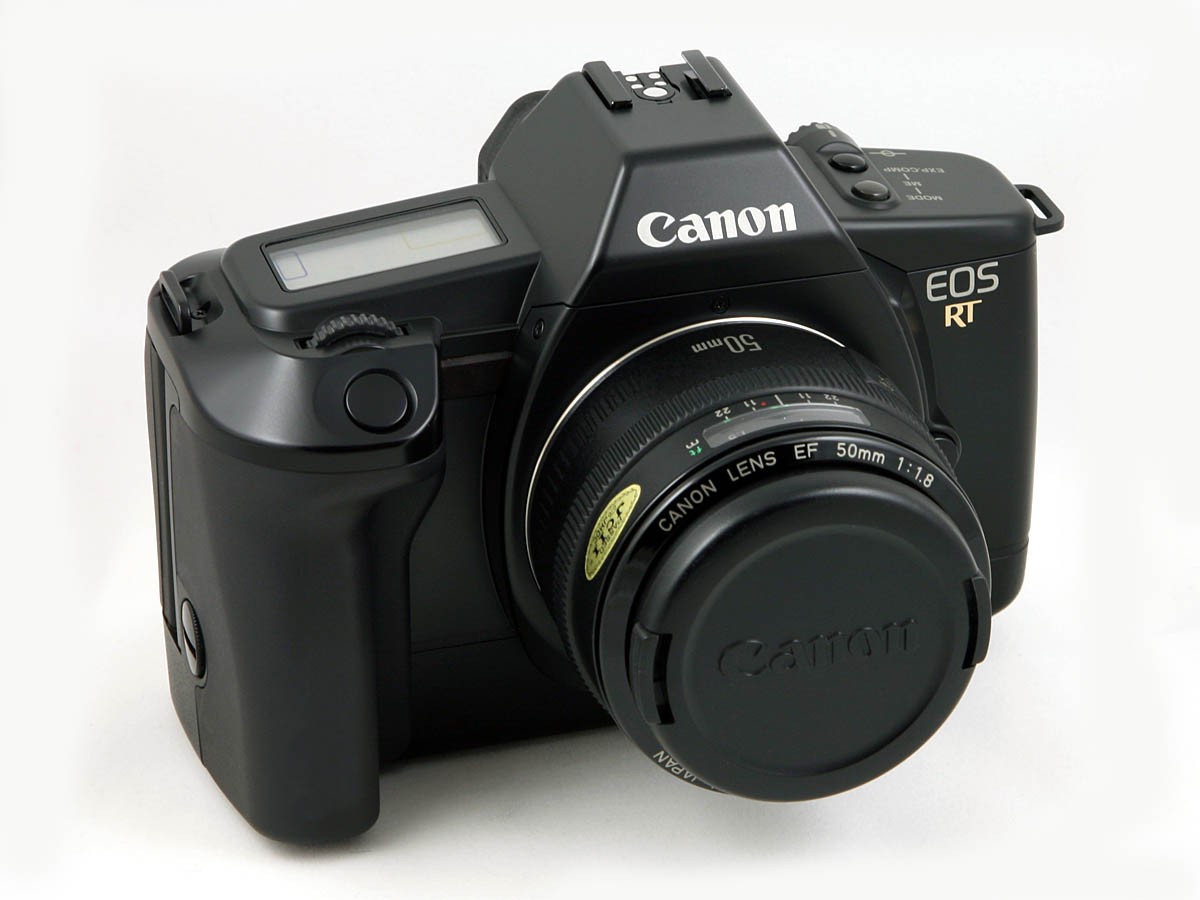
Photo courtesy of DP Review.
_________________
"I've got a Nikon camera, I like to take a photograph" - Paul Simon |
|
| Back to top |
|
 |
stevemark

Joined: 29 Apr 2011
Posts: 3754
Location: Switzerland
|
 Posted: Sat Mar 25, 2023 9:50 pm Post subject: Re: Canon EOS RT Posted: Sat Mar 25, 2023 9:50 pm Post subject: Re: Canon EOS RT |
 |
|
stevemark wrote:
| DigiChromeEd wrote: |
I've finally found a Canon EOS RT in as new condition without having to pay the silly money these are selling for in this condition.
I've now got in perfect condition a EOS 650, EOS 620, EOS 600 and an EOS RT all for under £150 for the lot. Happy days!!
|
Tht sounds good - congratulations! The RT is pretty rare here in Switzerland as well, but I've seen them going for around CHF 50.-- as well. That said, I never was really happy with EOS 650/620/600 series. Back in 1987, when I was about to buy AF SLR, the photo dealer insisted I should try the (then brand new) 620 before choosing my new SLR system. I got her EOS 620 over the weekend, plus a Minolta 9000, and could work with them side-by-side. For me, the decision was easy. I would go for Minolta ...
S
_________________
www.artaphot.ch |
|
| Back to top |
|
 |
stevemark

Joined: 29 Apr 2011
Posts: 3754
Location: Switzerland
|
 Posted: Sat Mar 25, 2023 10:47 pm Post subject: Posted: Sat Mar 25, 2023 10:47 pm Post subject: |
 |
|
stevemark wrote:
Today I got an interesting Nikon AF lens (read Haruo Sato's "NIKKOR - The Thousand and One Nights No.65": https://imaging.nikon.com/imaging/information/story/0065/index.html).
The lens came with a like-new F80, but here I'll show it with my Nikon F5:

On the huge F5, the Nikkor AF 3.5-5.6/28-200mm superzoom more or less looks like a normal lens ... pretty amazing, how small that lens actually is!
And here's my F2, as previously promised, with the Nikkor 2/35mm lens discussed in the newest Nikkor Tale No 85 (https://imaging.nikon.com/imaging/information/story/0084/index.html):

Here it is again, this time with F2 plus motor drive. Quite a beast! And this very sample has a history of its own. Both the F2 as well as the Ai 2/35mm (plus a rare 4.5/300mm ED "non-IF", not shown here) did belong to a very famous European sportsman. I have promised not to mention his name, and I never will, of course ... It's always nice when such precious gear ends up with someone who really appreciates it 

That's another one I got recently, for free as well (thanks a lot!!). Usually I don't collect German cameras from the 1950s, but nevertheless quite a few of them have found a new home here. It would be a pitty to trash them, but nevertheless still many such cameras are being thrown away. Retina folder type with a Schneider Xenon 2/50mm lens:
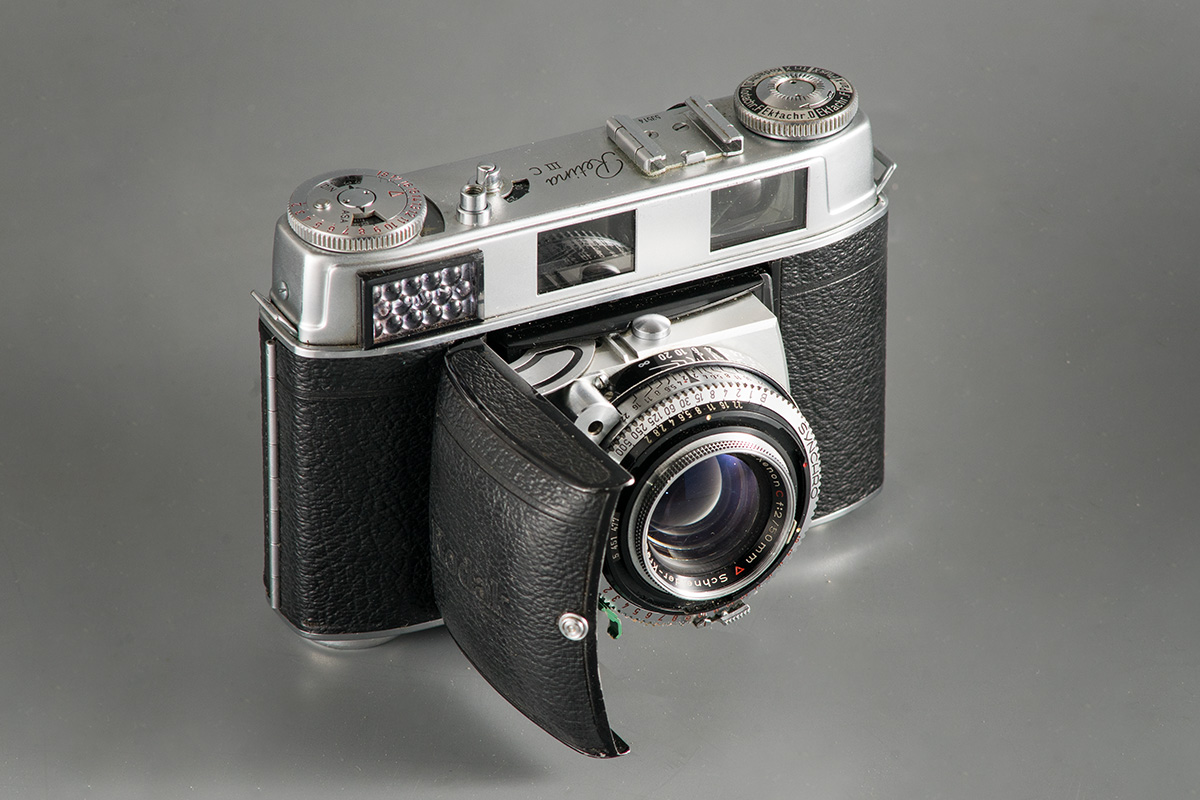
Finally a Rolleiflex SL35 with an unknown 1.4/50mm lens (front ring is missing; lens is probably a Zeiss Planar). I don't know much about German cameras and lenses - but a quick search did come up with only the Zeiss Planar 1.4/50mm as a f1.4 standard lens for the SL35. Sure enough, this one has a differerent optical construction than the contemporary Zeiss Planar 1.4/50mm for the Contax RTS (smaller diamater of the rear lens). Does anyone have more precise information?

OK ... that's it for today 
S
_________________
www.artaphot.ch
Last edited by stevemark on Sun Mar 26, 2023 9:35 pm; edited 1 time in total |
|
| Back to top |
|
 |
Doc Sharptail


Joined: 23 Nov 2020
Posts: 987
Location: Winnipeg Canada
|
 Posted: Sun Mar 26, 2023 12:09 am Post subject: Posted: Sun Mar 26, 2023 12:09 am Post subject: |
 |
|
Doc Sharptail wrote:
I let the black F2 I had here go- the mirror was getting very loud.
Yours looks as if it was produced the same day. 
Your F2 motor pic is not showing here.
I think there's an F80 in le junque pile here- it came as a lens cap for one or other of my nikkors.
I've never considered using it. That ingrained (false) mistrust of battery driven cameras runs deep  
Congrads on the Rolleiflex SL. They were quite well regarded here.
-D.S.
_________________
D-810, F2, FTN.
35mm f2 O.C. nikkor
50 f2 H nikkor, 50 f 1.4 AI-s, 135 f3.5 Q,
50 f2 K nikkor 2x, 28-85mm f3.5-4.5 A/I-s, 35-105 3.5-4.5 A/I-s, 200mm f4 Micro A/I, partial list.
"Ain't no half-way" -S.R.V.
"Oh Yeah... Alright" -Paul Simon |
|
| Back to top |
|
 |
stevemark

Joined: 29 Apr 2011
Posts: 3754
Location: Switzerland
|
 Posted: Sun Mar 26, 2023 10:00 pm Post subject: Posted: Sun Mar 26, 2023 10:00 pm Post subject: |
 |
|
stevemark wrote:
| Doc Sharptail wrote: |
I let the black F2 I had here go- the mirror was getting very loud.
Yours looks as if it was produced the same day.  |
Yes - it certainly had been treadted well.
| Doc Sharptail wrote: |
| Your F2 motor pic is not showing here. |
Oops ... just have fixed taht one. My mistake, sorry.
| Doc Sharptail wrote: |
I think there's an F80 in le junque pile here- it came as a lens cap for one or other of my nikkors.
I've never considered using it. That ingrained (false) mistrust of battery driven cameras runs deep   |
I grew up with battery driven SLRs - no problems  . I certainly would have missed may nice images without aperture priority AE (Mamyia ZE/ZM back then)! . I certainly would have missed may nice images without aperture priority AE (Mamyia ZE/ZM back then)!
The F80 actually looks & feels pretty god - everything one needs (plus a few nice "goodies"), and a nice clean design. HOWEVER the viewfinder is juts nuts: Small and extremly dark, even with an f1.4/50mm. I didn't know Nikon made such creepy viewfinders. Minolta "midclass" 7000 and Dynax 7 viewfinder are much larger and much, much brighter!!
| Doc Sharptail wrote: |
Congrads on the Rolleiflex SL. They were quite well regarded here.
-D.S. |
I have a few of them - all of them broken (shutter locked). It's a pity ... also a rare SL350, shutter locked as well.
_________________
www.artaphot.ch |
|
| Back to top |
|
 |
Doc Sharptail


Joined: 23 Nov 2020
Posts: 987
Location: Winnipeg Canada
|
 Posted: Mon Mar 27, 2023 5:36 am Post subject: Posted: Mon Mar 27, 2023 5:36 am Post subject: |
 |
|
Doc Sharptail wrote:
Interesting drive for the F2.
I have not seen that battery pack configuration before.
Could you show the rear of the drive when you have time?
-D.S.
_________________
D-810, F2, FTN.
35mm f2 O.C. nikkor
50 f2 H nikkor, 50 f 1.4 AI-s, 135 f3.5 Q,
50 f2 K nikkor 2x, 28-85mm f3.5-4.5 A/I-s, 35-105 3.5-4.5 A/I-s, 200mm f4 Micro A/I, partial list.
"Ain't no half-way" -S.R.V.
"Oh Yeah... Alright" -Paul Simon |
|
| Back to top |
|
 |
stevemark

Joined: 29 Apr 2011
Posts: 3754
Location: Switzerland
|
 Posted: Tue Mar 28, 2023 8:19 pm Post subject: Posted: Tue Mar 28, 2023 8:19 pm Post subject: |
 |
|
stevemark wrote:
| Doc Sharptail wrote: |
Interesting drive for the F2.
I have not seen that battery pack configuration before.
Could you show the rear of the drive when you have time?
-D.S. |
Sure - maybe tomorrow, maybe during the weekend. This week I'm quite busy helping some neighbours building their house ... ten hours of hard "manual" work today, so I'm quite tired  But it's fun and I learn a lot which is useful for my own house! But it's fun and I learn a lot which is useful for my own house!
S
_________________
www.artaphot.ch |
|
| Back to top |
|
 |
|
|
